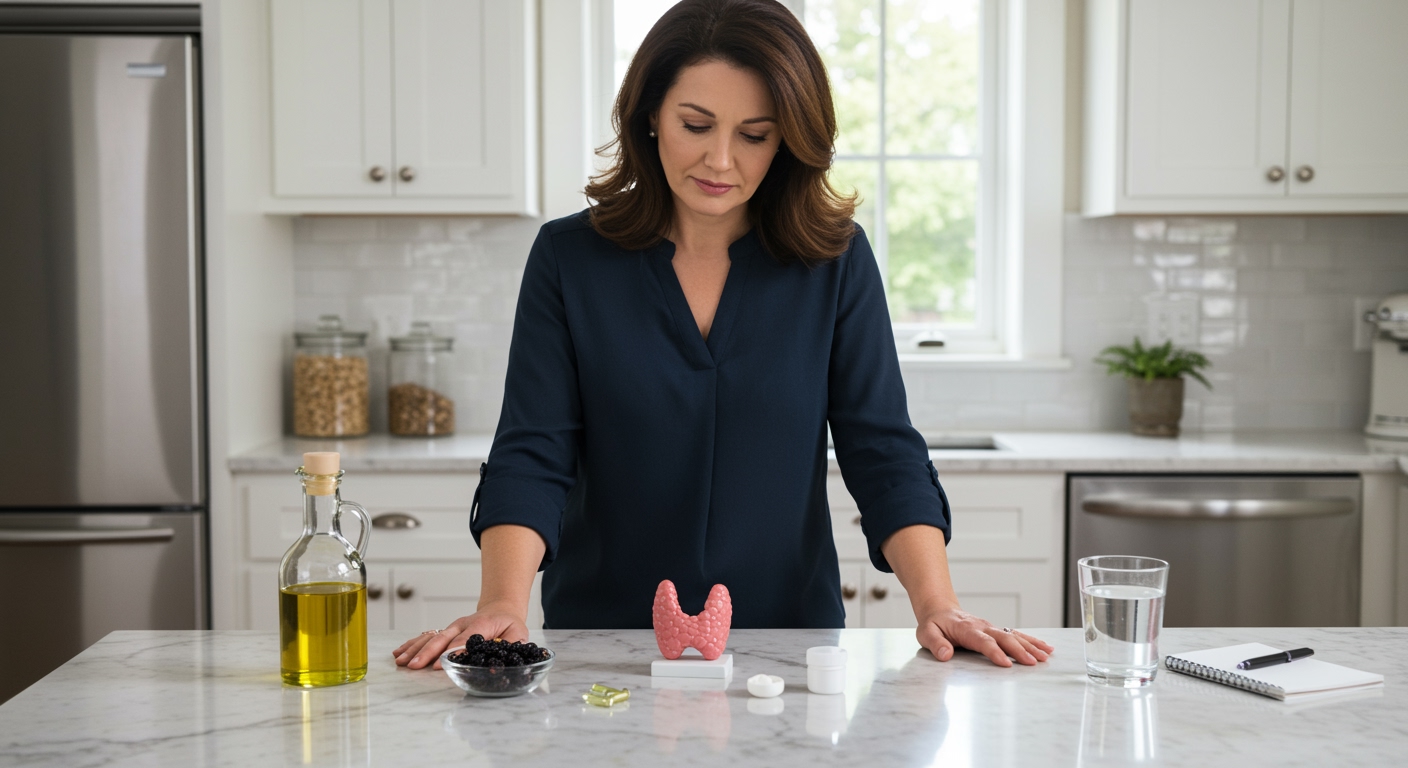✪ Key Takeaway: Branzino is good for hypothyroidism because it provides selenium and omega-3s that support thyroid function without goitrogenic compounds.
Introduction
You walk through the fish market and spot branzino on ice, looking fresh and inviting.
Your doctor told you to eat more fish for your hypothyroidism, but you wonder if this particular fish actually helps or just adds to your confusion about what to eat.
Hi, I am Abdur, your nutrition coach, and today I am going to explain exactly how branzino affects your thyroid health and whether it deserves a regular spot on your plate.
What Makes Branzino Different From Other Fish?
Branzino is a Mediterranean sea bass that has become incredibly popular in restaurants and home kitchens across the world.
This white fish has a mild, delicate flavor that makes it appealing even to people who typically avoid seafood.
The texture is firm yet flaky, which means it holds up well during cooking without falling apart.
Most branzino sold today comes from Mediterranean aquaculture farms where fish are raised in controlled environments.
A typical serving of branzino provides about 20 grams of protein with only 3 grams of fat.
The low mercury content makes branzino safer than larger predatory fish like tuna or swordfish.
This fish contains minimal bones compared to many other species, making it easier to prepare and eat.
✪ Fact: Branzino farming began in the Mediterranean region during the 1960s and has since become one of the most sustainable aquaculture practices worldwide.
How Does Hypothyroidism Affect Your Nutritional Needs?
Hypothyroidism occurs when your thyroid gland does not produce enough hormones to regulate your metabolism properly.
This small butterfly-shaped gland in your neck controls how your body uses energy from food.
When thyroid hormone levels drop, your metabolism slows down, leading to weight gain, fatigue, and cold sensitivity.
Your thyroid needs specific nutrients to function correctly, particularly iodine, selenium, and zinc.
Selenium acts as a cofactor for enzymes that convert inactive thyroid hormone T4 into active T3.
Without adequate selenium, this conversion process slows down, worsening hypothyroid symptoms even if you take medication.
Research shows that people with hypothyroidism often have lower selenium levels than those with normal thyroid function.
✪ Note: Hypothyroidism affects approximately 5 out of every 100 people in developed countries, with women being significantly more likely to develop this condition than men.
What Nutrients In Branzino Support Thyroid Function?
Branzino provides an excellent source of selenium, delivering about 40 micrograms per 100-gram serving.
This amount covers roughly 70 percent of your daily selenium requirement from just one moderate portion.
The omega-3 fatty acids in branzino help reduce inflammation throughout your body, including in your thyroid gland.
Chronic inflammation can interfere with thyroid hormone production and worsen autoimmune thyroid conditions like Hashimoto thyroiditis.
Branzino also contains vitamin D, which plays a role in immune system regulation and may help prevent autoimmune thyroid disease.
The high-quality protein in this fish provides amino acids your body needs to build thyroid hormones and transport them through your bloodstream.
Unlike some vegetables that contain goitrogens, branzino has no compounds that interfere with thyroid function.
✪ Pro Tip: Pair branzino with selenium-rich side dishes like brown rice or Brazil nuts to maximize your thyroid-supporting nutrient intake at each meal.
Can Branzino Replace Your Thyroid Medication?
No food, including branzino, can replace prescribed thyroid medication for managing hypothyroidism.
Thyroid hormone replacement therapy provides synthetic hormones that your body cannot produce in sufficient quantities.
Branzino works as a complementary food that supports your overall thyroid health alongside medication.
The nutrients in this fish help your body use thyroid medication more effectively by supporting hormone conversion and reducing inflammation.
Think of branzino as part of a comprehensive approach that includes medication, proper nutrition, stress management, and adequate sleep.
Some people with mild hypothyroidism may see symptom improvement from dietary changes alone, but this requires medical supervision.
Never stop or reduce your thyroid medication without consulting your doctor, even if you feel better after adding branzino to your diet.
✪ Note: Regular thyroid function tests help your doctor determine whether your medication dosage needs adjustment based on your symptoms and blood work results.
How Often Should You Eat Branzino For Thyroid Health?
Eating branzino two to three times per week provides consistent thyroid-supporting nutrients without overdoing it.
This frequency allows you to benefit from selenium and omega-3s while leaving room for other nutritious foods in your diet.
A standard serving size of branzino is about 150 grams, which fits nicely on a dinner plate alongside vegetables and whole grains.
You can rotate branzino with other low-mercury fish like salmon, sardines, and mackerel to get variety in your nutrient intake.
Preparing branzino at home gives you control over cooking methods and allows you to avoid excess salt or unhealthy fats.
Grilling, baking, or steaming branzino preserves its nutritional value better than deep frying.
If you eat branzino more than three times weekly, you might miss out on nutrients from other protein sources like poultry, legumes, and eggs.
✪ Pro Tip: Buy whole branzino when possible and ask your fishmonger to clean it for you, as the freshest fish provides the most nutrients and best flavor.
The Bottom Line
Branzino is genuinely good for hypothyroidism because it delivers selenium, omega-3s, and high-quality protein without any thyroid-disrupting compounds.
The best diet for thyroid health is one that includes a variety of nutrient-dense whole foods, not just one magic ingredient.
I would love to hear your experience with branzino or any questions you have about managing hypothyroidism through nutrition, so please share your thoughts in the comments below.
References
At NutritionCrown, we use quality and credible sources to ensure our content is accurate and trustworthy. Below are the sources referenced in writing this article:
- Cleveland Clinic: Hypothyroidism
- Global Seafoods: A Comprehensive Guide to Branzino Fish Origins Nutritional Benefits and Cooking Tips
- National Center for Biotechnology Information: The Effect of Selenium Supplementation on Thyroid Hormone Metabolism in Patients with Autoimmune Thyroiditis
- Frontiers in Endocrinology: Omega-3 Fatty Acids and Inflammatory Processes
- Mayo Clinic: Hypothyroidism Symptoms and Causes





